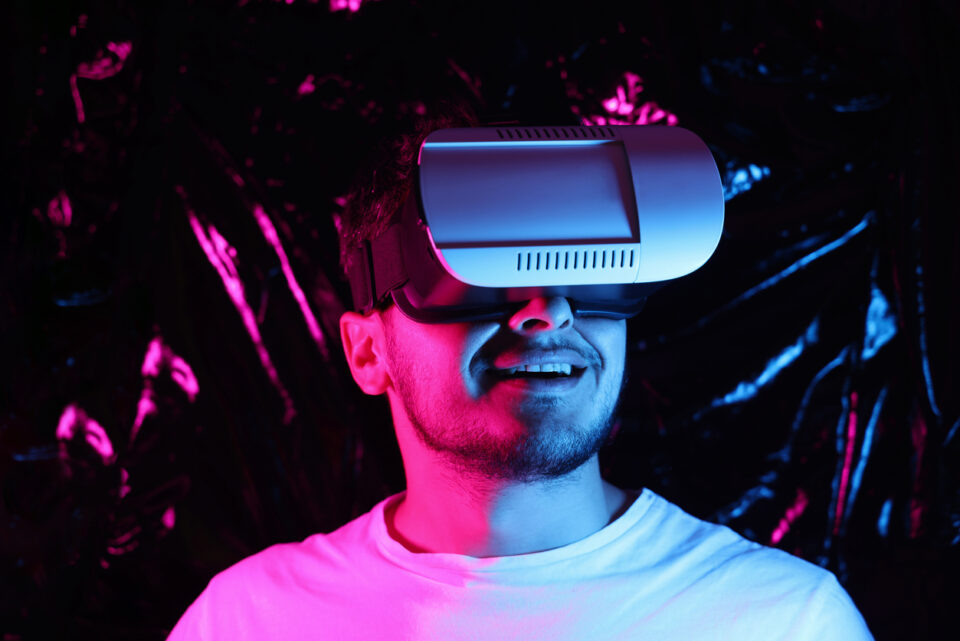

Step aside, Bitcoin. There’s a new buzzword in the up-and-coming tech world.
The term “metaverse” has recently entered the public consciousness, largely thanks to Facebook’s company rebrand to Meta Platforms. But what exactly is the metaverse, and is it truly the next step in web tech’s evolution? Trying to fully envision what the metaverse could be is a bit like imagining today’s internet back in 1970. The general idea is there, but it’s hard to know exactly how it will come to life.
How We Got to the Metaverse
For years, companies have been making strides in virtual reality (VR) and augmented reality (AR). These two technologies are the building blocks of the metaverse. Already, companies like Target allow users to see how furniture would fit in their homes using AR, just by activating the camera within its app. Snapchat’s AR features, while more focused on entertainment, are especially popular as well.

For a more immersive experience, users can strap on a VR headset like those made by Oculus. VR users can fully immerse themselves in a virtual world. There’s the option to buy clothes, customize your avatar, meet up with friends, attend concerts, and much more.
Even without special equipment, virtual worlds already exist and have gained considerable traction. If you have kids, you’ve surely heard of Fortnite, the wildly popular online game. With just a computer, players can compete, chat with others, and purchase items. Fortnite is one component of the metaverse – a virtual universe that continues to exist once a user logs off.
There’s no denying that tech developers are at the forefront of the metaverse, but they aren’t the only ones interested in shaping the experience. Investors from real estate to automotive are vying to build influence in this budding space. One firm recently paid $4.3 million for land in Sandbox, one of a handful of virtual platforms that make up the current metaverse.
With all of this attention, what opportunities lie ahead for brands?
Automotive Sales in the Metaverse
Right now, there are two major areas of opportunity shaping up for dealers in the metaverse.
First, with a new virtual space comes the prospect of advertising. The metaverse is already being positioned as a place for commerce – much like how customers already shop online, only more immersively. Virtual retail spaces and malls have already been built, and it’s simply a matter of time before advertisers find the best ways to reach the metaverse’s growing userbase.
With tech giants phasing out 3rd-party cookies, the metaverse represents an opportunity for a different kind of advertising. Rather than relying on tracking a single user, these virtual spaces could be excellent venues for contextual advertising. The nature of the metaverse also makes it easier for users to opt into advertising. For example, a platform can specify that by turning on a VR headset and logging into a metaverse platform, the user consents to personalized advertising. This is significant as opting in has become increasingly important to both consumers and brands.
For automotive brands and dealerships looking to grab attention and win customers, it’s never too early to begin exploring the next opportunity zone for advertising.
Secondly, as online car-buying has become more prevalent since the pandemic, the metaverse could offer a bridge between the dealership and the customers shopping from home. Already, Hyundai has launched its “Hyundai Mobility Adventure.” This metaverse space is hosted on Roblox, a platform with 43.2 million daily users. Users can join the Hyundai Mobility Adventure to test drive cars, explore the future of Hyundai innovation, and replicate the experiences of engineers and designers.
While the Hyundai metaverse exists at a tier 1 level, tier 3 dealerships could benefit from similar access in the future. As the metaverse evolves, it could provide an avenue for viewing vehicles and interacting with salespeople in a more fluid fashion, versus shopping on a website. Of course, a virtual test drive is no replacement for real life, but a massive opportunity lies in increasing convenience and decreasing friction during the customer’s journey to purchase.
What’s Next for the Metaverse
There are still years of development ahead of us before the metaverse becomes a truly mainstream service. By familiarizing yourself with the concept and the possibilities now, you can be poised to seize the business opportunities that are on the horizon.
In the meantime, Strong Automotive Merchandising offers a full suite of digital marketing services to keep you in front of today’s evolving shoppers – no VR headset needed. Learn more about reaching customers, no matter which device they’re using.
Posted
John Paul Strong
John Paul Strong combines his two decades of automotive marketing experience with a team of more than 150 professionals as owner and CEO of Strong Automotive.
Explore
Recent Posts


Recent Generations Turn to Social Media for Searches instead of Google

What a TikTok Ban Could Mean for Dealers
Archive
